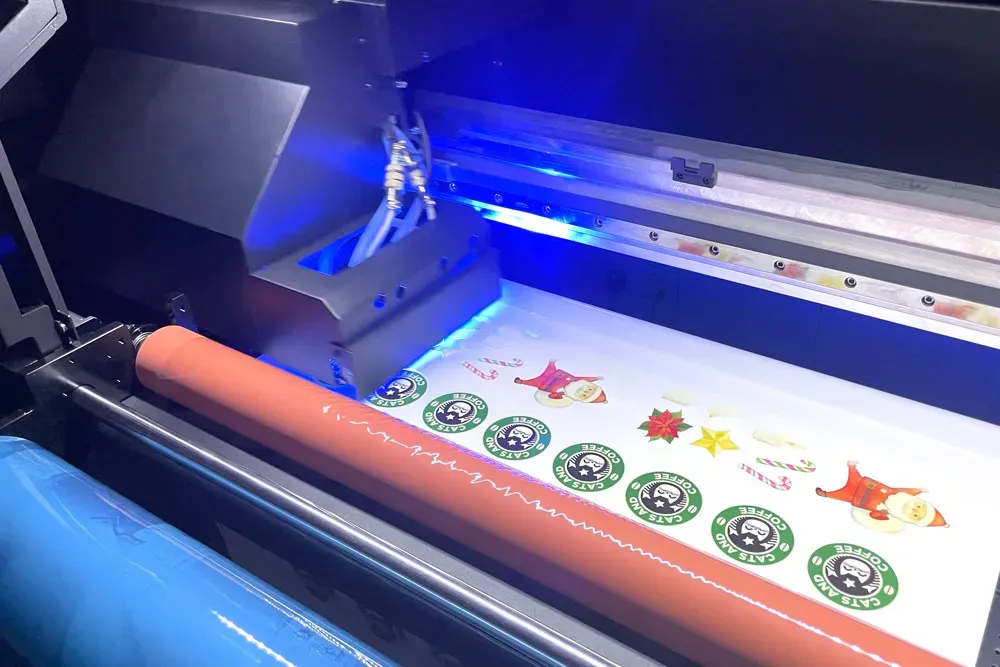UV DTF printing is revolutionizing the world of custom printing by combining durability and creative potential in a single method. This innovative printing technology utilizes ultraviolet-cured inks to ensure high-quality DTF printing results that can withstand the test of time. As artists and businesses strive for eye-catching designs, understanding the best practices for UV DTF can elevate the output significantly. With the right UV DTF printing tips and approaches, you can produce stunning graphics on a variety of surfaces, making this technique highly versatile. Embracing the advancements in creative UV printing is essential for anyone looking to thrive in today’s competitive market.
Also known as UV Direct-to-Film printing, this approach leverages advanced printing techniques to deliver exceptional quality and versatility. By using UV-curable inks, printers can achieve vibrant colors and impressive durability across numerous materials. The applications of UV DTF are vast, from personalized clothing to promotional items, showcasing its adaptability in various industries. Understanding this emerging printing technology will not only enhance the quality of your projects but also streamline the production process, opening up new possibilities for creative expression.
Optimizing Your UV DTF Printing Settings
When it comes to UV DTF printing, meticulously optimizing printer settings is fundamental to achieving superior results. Adjustments should be made according to the material types you are printing on. For instance, printing on cotton or polyester may necessitate different ink densities and print resolutions. To perfect your outputs, conduct thorough tests to identify the ideal settings that will maintain the vibrancy and clarity of your prints.
Additionally, consider factors such as the height of the print head and the type of ink you are using in your UV DTF printing process. Using higher quality inks can lead to more striking colors and better adhesion. By experimenting with settings like speed and temperature, you can significantly enhance the overall quality and details of your prints, ensuring that the final product meets or exceeds your expectations.
The Importance of Surface Preparation for DTF Printing
Surface preparation is an essential step in UV DTF printing that is often overlooked. The substrate must be thoroughly cleaned to remove dust, oils, and other contaminants that could interfere with ink adhesion. Failure to prepare surfaces properly will likely result in poor print quality, leading to issues such as peeling or fading of the design over time. Using a microfiber cloth and appropriate cleaning agents can significantly improve adhesion.
Moreover, the type of substrate also plays a crucial role in the printing process. Different materials may require specific types of primers or treatments to ensure that the UV DTF films bond correctly. For example, smooth plastics may benefit from a specialized primer that enhances ink retention, resulting in longer-lasting prints. Ensuring you prioritize surface preparation will lead to outstanding and durable outcomes in your projects.
Layering Techniques for Enhanced UV DTF Prints
Mastering layering techniques in UV DTF printing can elevate your designs to a professional standard. By applying multiple layers of ink, designers can create rich textures and visually captivating depth within their prints. This approach not only enhances the aesthetic appeal but also contributes to a more robust print that withstands wear and tear better than single-layer prints.
Additionally, layering opens the door to creative opportunities, allowing for intricate designs and color gradients that are simply unattainable with standard printing methods. By experimenting with the thickness and order of ink layers, you can discover unique styles and effects that distinguish your work in the marketplace and impress your clients.
Understanding the Curing Process in DTF Printing
A critical aspect of UV DTF printing is the curing process, where UV light is used to solidify ink on the film before transfer. This process is not just about the duration of light exposure but also involves the intensity and distance of the UV light source. Proper curing ensures that the inks are bonded firmly to the film, preventing smudging or fading during handling.
To achieve the best results, it’s crucial to monitor the curing conditions closely. Inadequate curing can lead to poor adhesion and longevity issues. You may also want to use a UV light meter to ensure that the output is consistent across various prints. By mastering the curing process, you can ensure that your UV DTF prints maintain their quality over time and can endure repeated use.
Troubleshooting Common UV DTF Printing Issues
Like any printing technology, UV DTF printing can encounter common issues that may affect the quality of your projects. Problems such as inconsistent print quality, adhesion failures, or ink smudging can stem from a variety of factors, from incorrect printer settings to inadequate surface preparation. It’s essential to be familiar with these issues and their solutions so you can quickly diagnose and fix problems.
For example, if your prints are streaky or have poor color vibrancy, going back to adjust your printer settings may be necessary to ensure optimal ink output. Additionally, always reassess your surface preparation process since inadequate cleaning of substrates is a frequent cause of adhesion failure. By being proactive about troubleshooting, you can maintain exceptional quality in your UV DTF projects.
Exploring Creative Applications of UV DTF Printing
The versatility of UV DTF printing allows for a wide array of creative applications, making it an invaluable tool for artists and businesses alike. Whether you are looking to create custom apparel, unique promotional items, or personalized home décor, UV DTF printing provides the flexibility to tackle various projects with ease. This technology empowers you to bring your artistic visions to life with high-quality outputs that stand out.
With innovations like compact UV printers gaining popularity, creators can experiment with multiple surfaces and designs. For example, you could combine traditional textile printing with UV technologies to achieve prints that are more resistant to fading over time. Embracing the creative potential of UV DTF printing not only expands your business offerings but also allows for the development of specialized, high-quality products tailored to your clients’ needs.
Frequently Asked Questions
What are the key benefits of UV DTF printing?
UV DTF printing offers numerous benefits, including high durability and vibrant colors thanks to UV-curable inks. The rapid curing process allows for immediate handling of prints, which promotes high-volume production without sacrificing quality. Additionally, it can be applied to various substrates, making it an extremely versatile printing technology.
How can I optimize my printer settings for UV DTF printing?
To achieve the best results in UV DTF printing, optimizing printer settings is essential. Depending on the substrate—be it cotton, polyester, or plastic—you should adjust the ink density, print resolution, and curing time accordingly. Testing different configurations can lead to significantly improved print quality.
What surface preparation steps are crucial for successful UV DTF printing?
Proper surface preparation is vital for UV DTF printing. Always ensure that the substrate is clean and free from dust, oils, or residues. This can be achieved by wiping the surface with a suitable cleaner and allowing it to dry completely before applying the UV DTF transfers, thus ensuring better adhesion and print quality.
What are the best practices for layering techniques in UV DTF printing?
Layering techniques in UV DTF printing can enhance the depth and vibrancy of your designs. Applying multiple layers of ink can create rich textures and colors. Experiment with different layering techniques while ensuring proper curing after each layer to achieve optimal results in your prints.
How does the curing process affect UV DTF print quality?
The curing process is crucial in UV DTF printing as it determines the longevity and durability of the prints. Adequate and uniform exposure to UV light is necessary to prevent issues like fading or damage. Ensure that the curing time is appropriate for the ink used, as well as the design complexity.
What common issues might occur with UV DTF printing, and how can I troubleshoot them?
Common issues in UV DTF printing include inconsistent print quality, adhesion problems, and ink smudging. Troubleshoot by checking and adjusting printer settings for ink density and material type, ensuring proper surface preparation, and verifying that the curing process is comprehensive and uniform to avoid print defects.
| Key Points | Details |
|---|---|
| UV DTF Printing | A method using UV-curable inks for high-quality prints on various substrates. |
| Innovative Technology | Fast curing with UV light allows for immediate handling without smearing. |
| Surface Preparation | Clean and dry substrates ensure better adhesion and print quality. |
| Printer Settings | Adjust settings based on the substrate for optimal results. |
| Film Quality | High-quality films enhance durability and vibrancy of prints. |
| Layering Techniques | Using multiple layers can enhance depth in designs. |
| Curing Process | Consistent and adequate UV exposure ensures ink longevity. |
Summary
UV DTF printing represents a revolutionary advancement in printing technology, offering fast, durable, and high-quality results. This innovative method leverages UV-curable inks that dry instantly upon exposure to UV light, making it suitable for a wide range of substrates, from textiles to plastics. Proper surface preparation, optimized printer settings, and the use of high-quality materials are essential for achieving exceptional prints. As custom apparel and promotional items become increasingly popular, UV DTF printing opens up endless creative possibilities for designers and businesses alike. By mastering techniques such as layering and ensuring meticulous curing processes, users can unlock the full potential of this remarkable printing technology. Investing in quality equipment and materials will ultimately enhance your printing outcomes.

